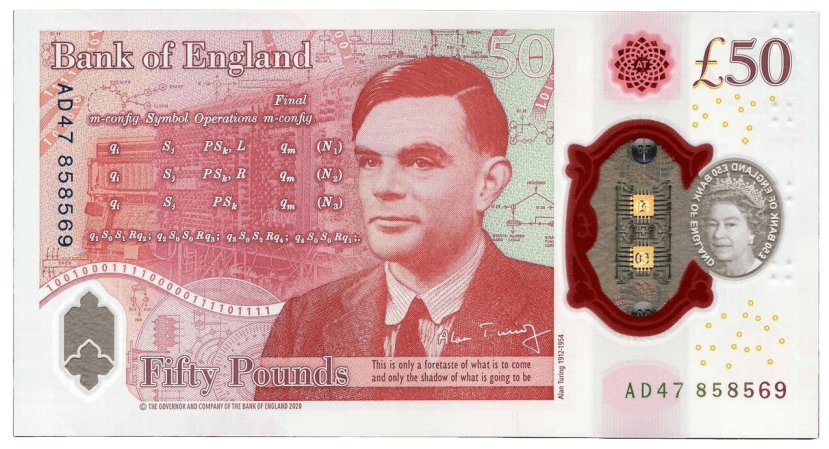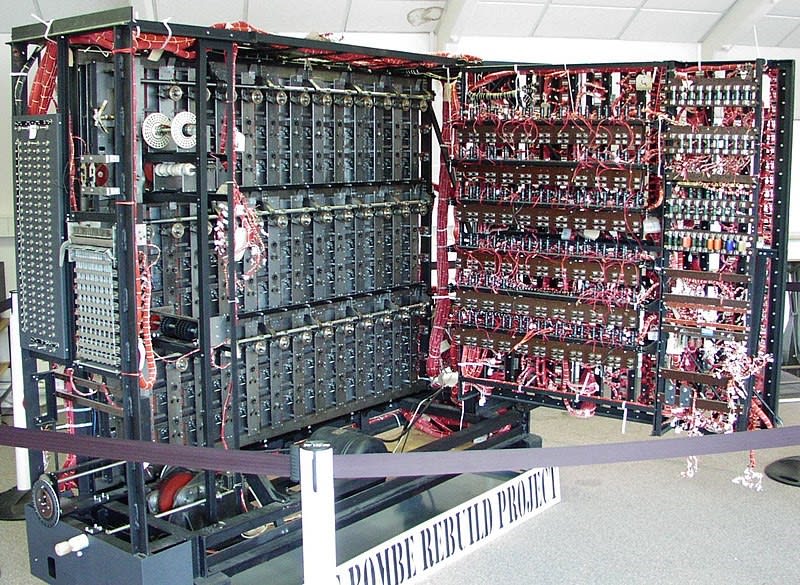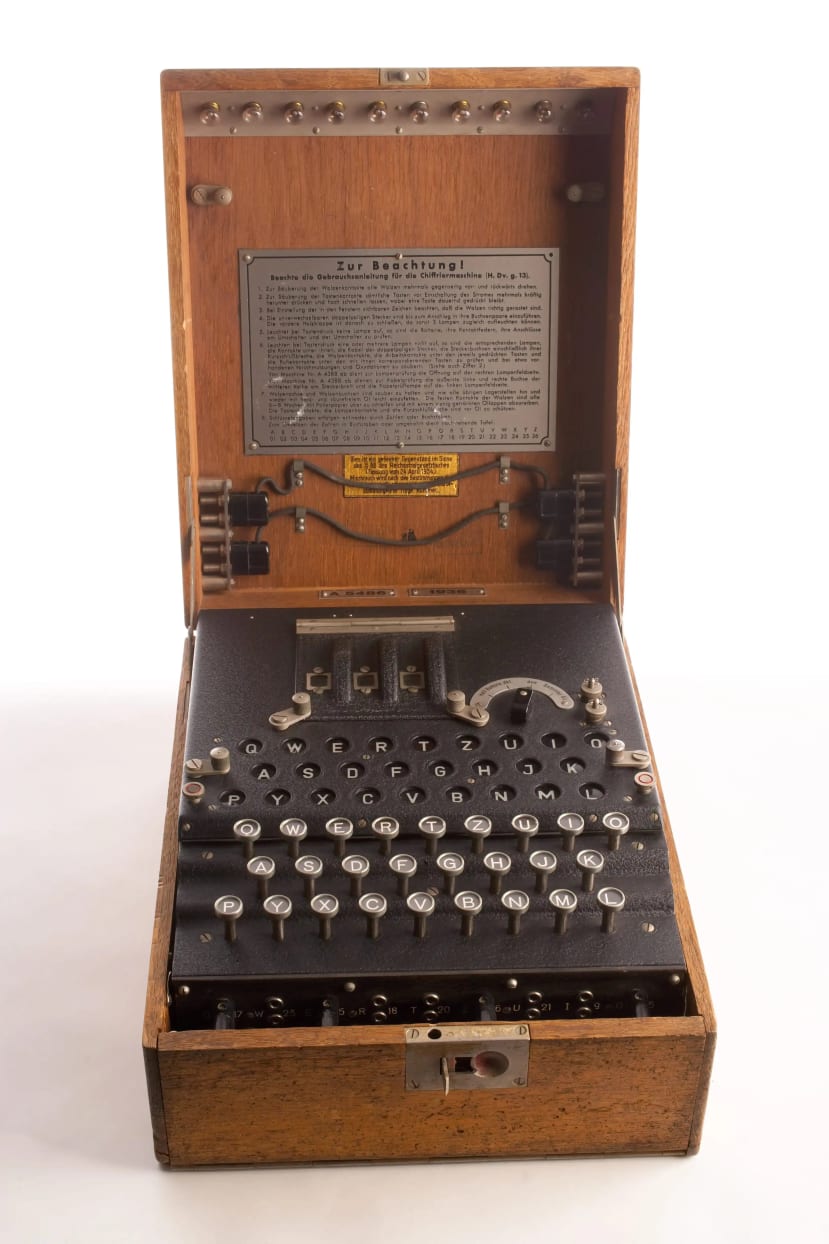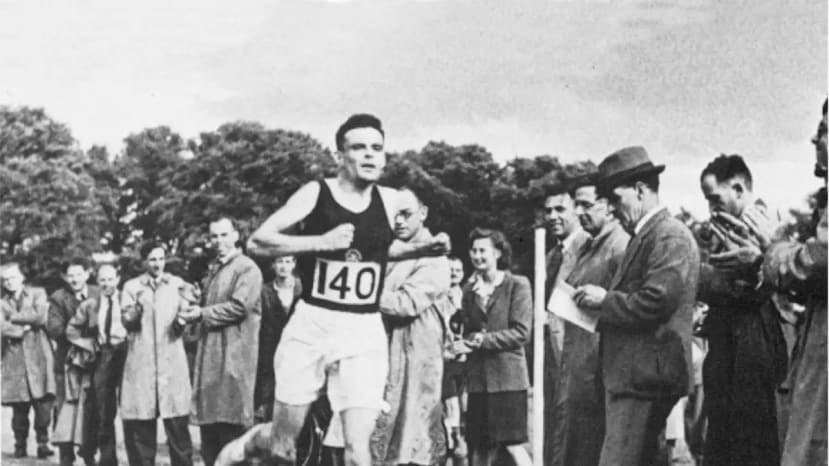Heroes of Tech: Alan Turing
Although cash itself is becoming something of an enigma to younger generations, should you happen upon a UK £50 note, you will be treated to an admirable illustration of the life and times of our next ‘Hero of Tech’: Alan Turing.
The design includes a logic table and formula from his seminal paper, ‘On Computable Numbers..’ in the foreground, with an image of the Automatic Computing Engine (ACE) Pilot Machine behind it. Also in the background is a technical drawing for a ‘Bombe’ specified by Turing as a tool to break Enigma messages, along with a few state machine diagrams. A neat touch is the ticker tape with a binary representation of Turing’s birthday. Kudos to the designer for capturing so much in so little space.
Bio
Alan Mathison Turing was born on the 23rd June 1912 as the second child of Julius and Ethel Turing. Although he was born in Paddington, London, he would have been conceived in British India where his father served in the Indian Civil Service of the Madras Presidency. His mother (born Ethel Sara Stoney) was the daughter of the chief engineer of the Madras railway and it is perhaps through her DNA that Alan gained his interest in scientific and academic pursuits - the Irish physicist George Johnstone Stoney (1826-1911) was a relative - as his father and elder brother John followed classical interests more in tune with the societal expectations for upper middle-class gentlemen of the time.
Alan attended Sherborne, an English Public School in Dorset and went on to read mathematics at King's College, Cambridge from 1931. He received a distinguished degree in 1934, a Fellowship of King's College in 1935 and a Smith's Prize for his work on probability theory in 1936. Had he been so inclined, he was on course for a successful career as an appropriately eccentric King's mathematics don. Fortunately, the seeds for an entirely different path had already been planted.
The Entscheidungsproblem
Turing was already familiar with Russell and Whitehead's Principia Mathematica and the then-arcane subject of mathematical logic. From a lecture course in 1935 by Cambridge topologist M. H. A. Newman, Turing learned about Kurt Gödel's 1931 proof of the formal incompleteness of logical systems and the (then) open “Entscheidungsproblem” (or decision problem) posed by David Hilbert which asked: for any given mathematical proposition, is there a method to decide whether or not it is provable?
To make that determination, a precise and compelling definition of 'method' was needed. Turing’s proposition was inspired. Analysing what a person 'mechanically' performing a methodical process would do, he extended the mechanical aspect into the idea of a theoretical machine able to perform certain precisely defined elementary operations on symbols on paper tape. This is what has become known as the Turing Machine and Turing argued that the scope of such a machine would encompass everything that could count as a 'definite method' or what we would now call an algorithm. With the definition of computable numbers being what one of these machines could calculate, it was not too difficult to answer Hilbert's question: No such decision procedure exists.
In April 1936 Turing showed his results to Newman but at the same time, the Princeton logician Alonzo Church had developed a parallel thesis using lambda-calculus to formalise the concept of ‘effective computability’ in his paper An Unsolvable Problem of Elementary Number Theory. Turing's paper, On Computable Numbers with an application to the Entscheidungsproblem, ended up referring to Church's work, and was delayed until August 1936.
From September 1936 to July 1938, Turing enrolled as a graduate student, under Church, at Princeton University where he gained a PhD with his dissertation 'Systems of Logic Based on Ordinals'. As well as showing that his definition of computability coincided with Church's, the paper (perhaps Turing's deepest mathematical work) introduced Ordinal Logic and the idea of relative computing (where Turing machines are augmented with ‘oracles’, to study problems that cannot be solved by Turing machines) as an investigation of the possibility of resolving Gödel’s incompleteness using Cantor's method of infinites. In addition to his mathematical work, he studied cryptology and also built three of four stages of an electro-mechanical binary multiplier while at Princeton.
Recognising his talent, John von Neumann offered Turing a temporary post as his postdoctoral assistant at Princeton in 1938 but Turing instead returned to Cambridge.
World War II
From September 1938, Turing began working part-time with the Government Code and Cypher School (GC&CS) on the cryptanalysis of the Enigma cipher machine used by Nazi Germany; meeting occasionally with senior codebreaker Dillwyn 'Dilly' Knox in London.
Knox was another fellow of King’s and a veteran of World War I Admiralty codebreakers, Room 40. He was another fine English eccentric who liked to work sitting in a hot bath. He had broken earlier versions of Enigma, but the Germans had continued to upgrade the system, foiling the current British attempts to break it.
Little progress was made until July of 1939, when Knox went with an Anlo-French intelligence group to a conference at the Polish Cipher Bureau in Pyry, south of Warsaw. There he met Marian Rejewski, a Polish cryptographer and mathematician who had solved the plugboard-equipped Enigma being used by the Germans through permutation theory and designed electro-mechanical bomba machines to decrypt German messages. Although it was brilliant, the Polish work was limited by depending on a very particular way the Germans had been using the Enigma.
On September 4th, the day after Neville Chamberlain’s declaration of war on Germany, Turing arrived at Bletchley Park. By November 1939 Turing had completed the design of the bombe — a far more powerful device than the bomba, that could break any Enigma message if a small portion of plain text could be guessed correctly.
Rebuilt Bombe at the Bletchley Museum
The Enigma Machine
The Enigma machine itself went through many iterations from its first adoption by the German Navy in 1926, so there were substantial variations in hardware and operational procedures over time as well as between different branches of the German armed forces.
Battery-powered and highly portable, the Wehrmacht Enigma machine keyboard had twenty-six keys, each marked with a letter. It also had a lamp-board with twenty-six bulbs, each of which lit up a letter of the alphabet. When an operator sent a message he would key in each letter of the message. For each key press, an electromechanical rotor mechanism would scramble the letter before lighting a bulb. The operator’s assistant kept a note of which letters lit up. The now encrypted message would then be radioed out in morse code, prefixed with the sender's call sign, followed by that of the intended recipient.
The Enigma machine
The Enigma's original scrambler had 3 rotors with 26 electrical contacts on each side. The rotor's wiring diverted the current to a different position on the opposite side. When a key was pressed, an electric current flowed through an entry drum, then through the set of rotors to a reflector drum which resent it back through the rotors and entry drum, and out to light one of the lamps on the lamp-board.
Further, for each key press the right-hand or "fast" rotor would advance one position, changing the encipherment. For each full rotation, the fast rotor caused the middle rotor to advance one position; and a full middle rotor rotation caused the left-hand (or "slow") rotor to advance. Each rotor's position was indicated by a letter of the alphabet showing through a window. The order of each rotor in the device could also be swapped, giving six permutations.
Still, this only provided 105,456 different ways to set the scrambler, so in 1930 the German army introduced additional security with a Steckerbrett (plugboard) to further scramble letters.
By January 1939, the steckerbrett had been enhanced and procedures changed so that three rotors were chosen from a set of five (giving 60 possible rotor orders) for the army and air force Enigmas, and three out of eight (336 rotor orders) for the navy machines. This gave the Navy an impressive 1.8×1020 different enciphering combinations.
Cryptanalysis
The Bletchley cryptanalytic work was very much a team effort; for example, by taking advantage of the self-reciprocity of the plugboard element of the Enigma, Gordon Welchman came up with the "Diagonal Board" which made Turing's Bombe immensely more powerful.
Turing's section was 'Hut 8', which deciphered Naval (and in particular U-boat) messages, making it a key unit at Bletchley Park. Turing developed a process dubbed ‘Banburismus’, using sequential conditional probability to infer the likely wheel settings of Kriegsmarine Enigma machines; reducing the amount of bombe time required to break a message. As a quantifying measure of this probability, Turing (along with Irving Good) devised the ban which was later employed in the in the Turingery method for breaking the Lorenz cipher used on broadcast binary teleprinter traffic that carried German High Command strategic communications.
In November 1942, Turing left Hut 8 for the United States, liaising with the US Navy’s codebreakers and bombe-builders. He also spent time at Bell labs working on the encrypted vocoder system variously known as The Green Hornet, Project X and SIGSALY. Later in the war, following on from this work, he collaborated with REME officer Donald Bayley on the development of a portable secure voice scrambler at the Secret Service's Radio Security Service in Hanslope Park, codenamed Delilah.
When Turing returned to Bletchley Park in March 1943, his deputy Hugh Alexander had already taken charge of Hut 8. Turing became a general consultant to the now extensive Bletchley Park operation, where he saw the Lorenz ciphered 'Fish' material (as it was known) cracked by the Colossus machines that had been built by Thomas H. Flowers and his team of engineers at the Dollis Hill Post Office Research Station in London. The Mark 2 Colossus was brought into operation just before D-Day, clearly demonstrating the feasibility of large-scale digital electronic computing.
Computers and Artificial Intelligence
As far back as 1941, Turing was thinking about machine intelligence and he circulated a (unfortunately lost) paper among some Bletchley colleagues. This was without doubt the first paper in the field of Artificial Intelligence - though it wouldn't be called ‘AI’ until The Dartmouth Summer Research Project on Artificial Intelligence at Dartmouth College, New Hampshire in 1956.
To implement what he referred to as machine intelligence, Turing would need a capable machine. In 1944, while honing his electronic design skills with the Delilah project, he spoke to Donald Bayley about his idea of 'building a brain'.
By the end of the war, Turing uniquely had three key concepts buzzing around in his own brain that would make such a computer possible: firstly, his 1936 concept of the Universal Turing Machine; second, an understanding (from experience) of the speed and reliability of electronic technology and finally, a firsthand view of the shortcomings of solely hardware-based computing from his experience with the Colossus machines, which had no means to store programs. That meant each new task required the operators to alter the machine’s physical wiring, using plugs and switches, to change the logic. Colossus was also not general-purpose, being designed only for a specific cryptanalytic task.
The opportunity to build a machine that addressed these shortcomings, by implementing a physical Universal Turing Machine, fell into Turing’s lap in 1945, when John Womersley invited him to join the Mathematics Division of the National Physical Laboratory (NPL) in Teddington, London. The proposed computer was to be called the Automatic Computing Engine, or ACE – as an homage to Charles Babbage.
For a second time, Turing was pre-empted by a parallel American publication: this time by Von Neumann's First Draft of a Report on the EDVAC written in May 1945. But where this document provided Harry Huskey (the electronic engineer who later drew up the hardware specifications of the EDVAC) little in the way of technical specs, Turing's report on the ACE (written in late 1945) included detailed specifications of the hardware, with circuit designs and example code. Turing even provided an estimate of the cost at £11,200!
Initially, Tommy Flowers was tipped to build the ACE but his Post Office workload made that impossible. This was unfortunate, as Turing's colleagues at the NPL didn't know about Colossus II (built using 2,400 thermionic valves) and thought ACE was too ambitious. The Official Secrets Act meant that Turing couldn't explain that he already knew his ideas could be implemented. Although his 1947 ‘Abbreviated Code Instructions’ marked the introduction of programming languages, Turing was frustrated to find himself without any influence in the engineering of the project. The result was a delayed and greatly scaled down ‘Pilot Model’ ACE finally demonstrated in 1950, while other computer projects at Cambridge and Manchester had gone on to take the technical lead in the race to build the world’s first stored-programme electronic digital computer. That crown was taken by the University of Manchester’s Computing Machine Laboratory, when the ‘Manchester Baby’ ran its first programme on 21 June 1948. However, an operating speed of 1MHz made the Pilot Model ACE the fastest computer in the world for some time.
Demonstrating the Pilot ACE in 1950
In February 1947 Turing lectured about the ACE to the London Mathematical Society, providing the earliest public mention of computer intelligence when he discussed the idea of machines acting intelligently enough to beat human opponents at chess stating:
‘What we want is a machine that can learn from experience’ and that ‘the possibility of letting the machine alter its own instructions provides the mechanism for this’.
Turing also discussed programming, which he called ‘instruction tables’. He had been working on this for over a year and had even developed the idea of subroutines that he called 'subsidiary tables'.
From October 1947, Turing spent the academic year back in Cambridge where he studied neurology and physiology. From this work, he wrote a pioneering paper on what we now call neural nets, bolstering his earlier propositions that sufficiently complex computer systems could exhibit learning ability. This was submitted to the NPL as an internal report, but never published in his lifetime.
In May 1948, Max Newman offered Turing the post of Deputy Director of the computing laboratory at Manchester University. Turing accepted and moved in October 1948 after resigning from the NPL.
It transpired that Turing had no control over the project - which was determined by its necessity in British atomic bomb development, so his only input was a programming manual. Turing pursued other intellectual interests, out of which came the most far-reaching expression of Turing's philosophy of machine and Mind in the paper Computing Machinery and Intelligence which appeared in the philosophical journal Mind in 1950.
The profundity of the Turing Test has been a stimulus to modern thinkers and the paper in general a lasting contribution to the philosophy of Artificial Intelligence research, but this was essentially the end of his contribution to the field.
In 1950 he began research into what he described as the mathematical theory of morphogenesis: the theory of growth and form in biology. He was a pioneer of the personal use of a computer in this research at his home in Wilmslow. The burning question for him being why asymmetry can arise out of initially symmetric conditions. His paper The Chemical Basis of Morphogenesis was submitted in November 1951, after he had already been elected to Fellowship of the Royal Society that July, for his work from fifteen years before. The morphogenesis paper was as original as his previous work and, long overlooked, it was a founding paper of modern non-linear dynamic theory.
Final Years
Alan Turing was arrested and tried in March 1952, after the police learned of his sexual relationship with a young Manchester man. He was unapologetic but rather than go to prison he accepted a year of oestrogen injections intended to neutralise his libido. He continued his work on morphogenetic theory but the secret work he continued to do for GCHQ (the successor to Bletchley Park) came to an abrupt end as homosexuals were ineligible for security clearance. Turing spoke bitterly of this exclusion to his wartime colleague Donald Bayley, who was then an MI6 engineer.
Turing was found dead by his cleaning lady on 8 June 1954. He had died the day before by cyanide poisoning; a half-eaten apple by his bed. His mother believed he had accidentally ingested cyanide from his fingers after an amateur chemistry experiment, but the coroner's verdict was suicide.
Conclusion
Alan Turing was another Hero of Tech that was so much more than his famous accomplishments and it has been difficult to par his life down to this short biography, so many details have had to be left out from both his work and life. For example, Turing ran cross-country competitively and often amazed his colleagues by running to scientific meetings, arriving before those using public transport. Only injury prevented his selection for the British team in the 1948 Olympic Games.
Alan Turing competing in cross-country running
Eccentric and solitary he was also vivacious, original and forward-looking. He was certainly a giant among the Heroes of Tech and I hope we have inspired you to further reading on his life and work.








Comments